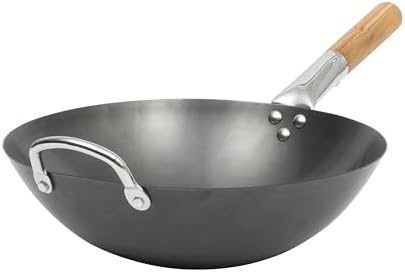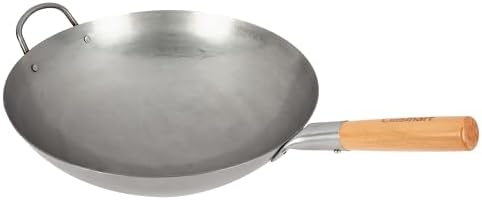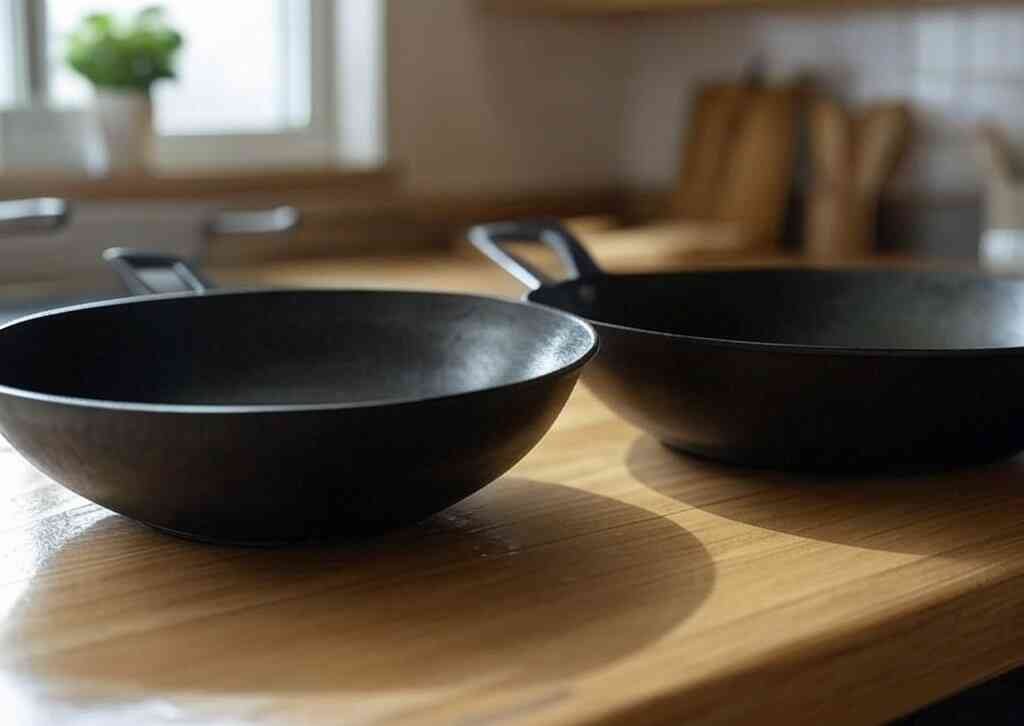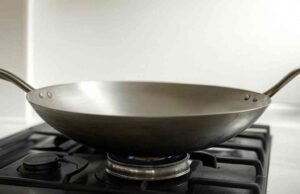The Art of the Carbon Steel Wok
Carbon steel wok is a staple of Asian cooking. Chefs sing its praises for its efficacy and versatility. This cooking vessel allows one to achieve “wok hei,” or wok breath. This imbues food with special flavor and aroma. In contrast to non-stick pans, the carbon steel wok possesses very good heat retention and reactivity. This makes the carbon steel wok the pet of chefs and food cooks alike.
It possesses a single identifying characteristic in that it may be easily managed at high heat. With seasoning, it is naturally non-stick. This makes cooking better because foods may be easily slid without adhering. This proves highly beneficial when stir-frying. Sealing fast at high heat is crucial for maintaining the texture of foods.
It would be necessary to use the correct carbon steel wok. Experts typically advise the use of a heavy-gauge wok. This enables greater heat conduction. It should have a flat or slightly curved bottom. This will depend on your cooktop. Most prefer a round bottom for use on conventional stoves. Good, comfortable handles are important too. They can make cooking all the more efficient. Once you’ve purchased your wok, take good care of it to make it last long.
A quick wash with hot water and drying keeps it from rusting. Occasional seasoning of your wok by applying a thin oil layer and heating it creates the essential non-stick coating. For wok cooking, preheating the wok is a must. This enables it to reach the perfect temperature before adding oil or food. This leads to better searing and flavor. Using these methods, you are able to unlock the full potential of the carbon steel wok. You can transform your cooking and enjoy the expression of this age-old utensil.
Getting Wok Hei: The Ghost Flame
Wok Hei, or ‘wok breath,’ is a feature of superior stir-fries. It is smoky and distinct-tasting and contributes to the overall flavor. This requires practice in attaining temperature, oil selection, and timing.
Preparation starts with preheating the carbon steel wok to the appropriate temperature. Place the wok on high heat. Allow it to heat to its optimum temperature (around 450°F to 500°F). The high heat is important. It promotes the Maillard reaction. This adds flavor and browning during cooking. Give sufficient time for the wok to heat right through. An effectively prepared surface is the basis for that sought-after ‘ghost flame’ look.
Another key factor is oil quality. Utilize high smoke point oils like grapeseed or peanut oil. They can take in a lot of heat without burning. When heated appropriately, oil creates a non-stick surface. This allows ingredients to sear, and in doing so, they absorb smoky flavors. Furthermore, add ingredients in the correct order. Start with aromatics like garlic or ginger. This allows their flavor to develop and shine through when other ingredients are added.
Timing matters as well. Stir-frying needs to be done swiftly. This preserves the food’s juiciness while adding a nice char. Do not overcrowd the wok. This may lower the heat and stifle Wok Hei. Practice these energetic techniques. This will hone your skills. You will, eventually, have that signature smoky taste that signifies professional cooking. After training, the pursuit of Wok Hei becomes second nature to your cooking abilities.
Professional Wok Cooking Techniques
Professional chefs must master the carbon steel wok. They work towards preparing exceptional meals. The wok is versatile in nature. It accommodates stir-frying, steaming, and deep frying. Each method enhances the flavors of ingredients. It also helps to add texture to the dishes. This is a fundamental difference between professional and domestic cooking.
One of the basic techniques used by chefs is stir-frying. It involves hot heat and rapid cooking periods. This keeps the color and newly acquired texture under control. The chef uses a seasoned carbon steel wok and controls the cooking surface temperature. This avoids hotspots. Flipping and tossing food is one of the basic elements of this. It requires proper wrist movement. This helps in flipping food completely without any loss.
Other than stir-frying, professionals usually steam in the wok. This retains moisture and results in more natural flavors. Using steaming baskets can also improve dishes. It provides a soft cooking process. This extracts subtle flavors without destroying the ingredients’ nutrients.
Deep-frying in a carbon steel wok is another practical technique. It allows chefs to achieve a crusty outer layer. It also keeps the inner portions soft. The shape of the wok is capable of withstanding heavy oil levels. Frying control is very important. Chefs normally emphasize the balance of flavors and textures. They utilize spices and seasonings judiciously.
Professional chefs employ specialized cooking tools. The best quality spatulas and tongs provide precision while cooking. AVOIDING pit falls is required. These include overcrowding the wok or poor control over temperature. Mastering these advanced techniques will improve your wok cooking. You can realize the potential of your carbon steel wok.
Recipes to Practice Advanced Wok Techniques
It takes practicing advanced wok skills to work with various recipes. This collection allows you to embrace Wok Hei philosophies. It also allows you to be well-versed with the skills. These recipes address the conventional flavors and modern tastes. They ensure an extensive grasp of wok cooking.
Classic Beef Chow Fun
For Cantonese cooking, use flat rice noodles that are heat-resistant. Preheat your carbon steel wok to optimal temperature. Stir-fry marinated beef in minimal oil for 30 seconds to achieve Wok Hei. Add garlic, scallions, and the rice noodles. Stir quickly for even cooking. The oil’s smoking point is key to achieving that charred taste.
Spicy Shrimp and Watercress Stir-Fry
Place fresh watercress on top for color. Sauté ginger and garlic in hot wok. Add the medium shrimp, chili paste for heat. Add the watercress at the end. Brief cooking time keeps the watercress firm. This provides textural contrast in the dish.
Fusion Tofu and Quinoa Bowl
For a contemporary flair, stir-fry tofu, prepared quinoa, and vegetables such as bell peppers and snap peas. Attention to detail is important: press and marinate the tofu in advance to enhance flavor. Following attainment of Wok Hei, present the dish on quinoa for protein and texture content. A sprinkle of sesame seeds and a drizzle of soy sauce will add to presentation and taste.
Each recipe emphasizes notable wok skills. These refine over time, sharpening your skills for Wok Hei recipes. Remember also to experiment substituting ingredients as per your taste. Be consistent with the techniques. Appearance counts; display your dishes well to showcase your works of culinary arts.












[…] The shape of the wok, possessing the unusual concave form and large surface area, is an excellent tool in speed cooking. Stovetop cooking is usually performed on flat surfaces that could restrict the rapid transfer of heat. The wok, however, is designed for rapid heating, with the curved bottom concentrating heat at the bottom and providing sufficient space to stir and toss food. The design allows for even heat distribution, which consequently minimizes cooking time and accelerates cooking food. […]
[…] soon realized my head’s picture was wrong. Great wok cooking depends on the right supporting cast of gear. Your beautiful wok is the star, but without the right […]
[…] Exactly Is Wok Hei?: cooking […]
[…] examine the most commonly employed wok sizes and the best way to put them to […]
[…] because a lid traps moisture. Stir-frying requires extremely high, dry heat for the attainment of wok hei (the smoky aroma) and to caramelize ingredients fast. When you cover the wok, steam rapidly builds […]
[…] Wok cooking is fast, flavorful, and fun but traditional woks can be heavy and hard to handle, especially for seniors or those new to cooking. The key is finding a lightweight, user-friendly wok that’s easy to lift, control, and maintain without sacrificing performance. […]
[…] authentic wok hei the smoky aroma and taste imparted by high-heat cooking is the ultimate goal of stir-frying. […]
[…] iron woks, the traditional choice has always been stainless steel tools, particularly the dedicated wok spatulas or chuan and ladles or […]